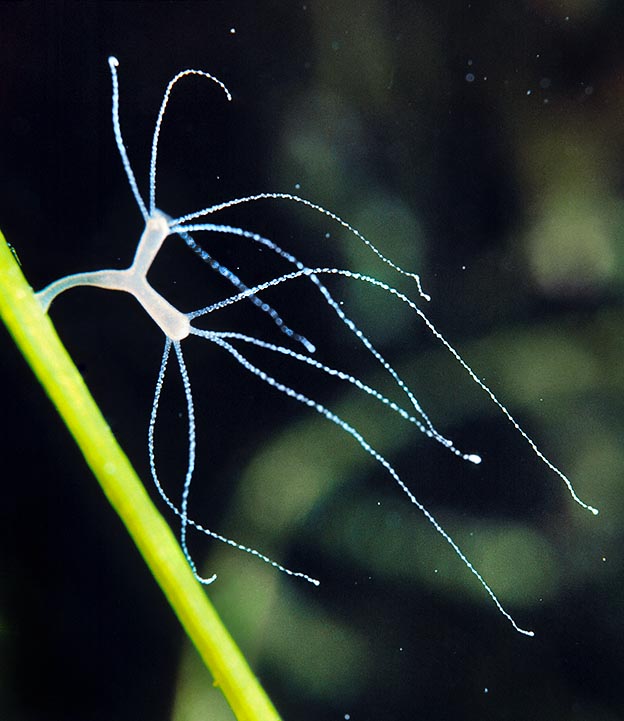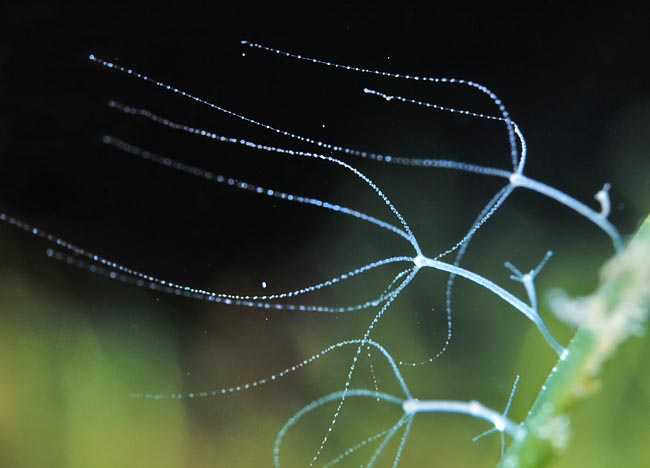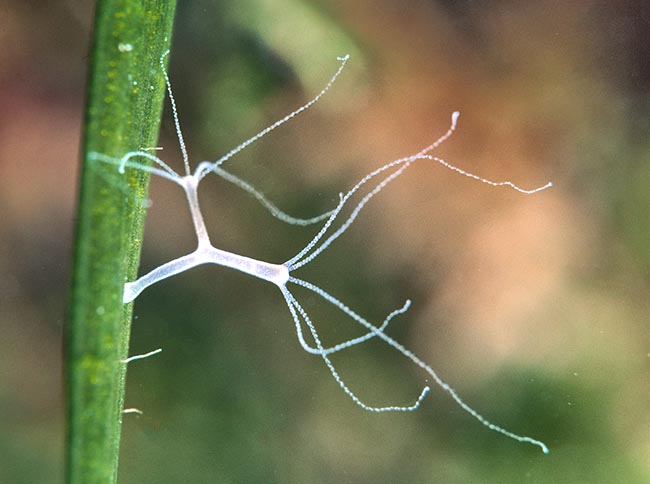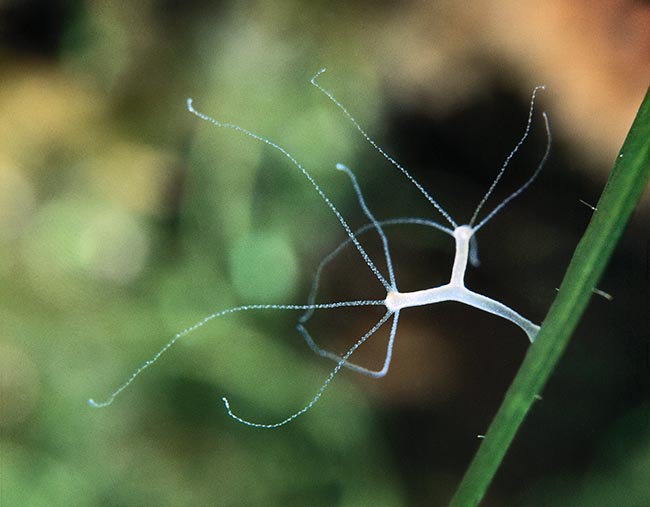Family : Hydridae

Text © Prof. Giorgio Venturini

English translation by Mario Beltramini

Numerous species and cosmopolitan subspecies belong to the group Hydra vulgaris © Giuseppe Mazza
The first report about the Hydra (Hydra vulgaris Pallas 1766), phylum Cnidaria, class Hydrozoa, family Hydridae, is probably to be ascribed to the Dutch microscopist Anton van Leeuwenhoek (1702-1703) but by sure the most accurate and complete study is that done by the Swiss Abraham Trembley 1744, who accurately describes the morphology, the extraordinary regenerative capacities and the locomotion mechanisms.
Trembley carried out most of his observations on the green hydra (Hydra viridissima) and recognized its belonging to the animal kingdom. During his experiments on the regeneration, Trembley gets a specimen with seven heads which it names “Hydra” in memory of the mythological Lernaean Hydra, the monster with many heads (nine after most of versions), capable to regenerate the cut heads, that Hercules faced and killed during the second of his famous “labours” (in this case, played unfairly as he was helped by his nephew Iolaus: Hercules did cut the heads and Iolaous cauterized the wound with a torch).
The analogy between the mythological monster and our Hydra goes further. The Hydra of Lerna was very poisonous: its breath was deadly and the blood was used by Heracles for poisoning his arrows (and by Deïanira for poisoning the famous shirt (the shirt of Nessus) which eventually led Heracles to his death). Equally poisonous is the bite of the stinging cells of the hydra, capable to paralyze in a few instants preys much greater than the hydra itself. On the basis of Trembley’s observations and the name “hydra” he attributed to its seven-headed specimen, Linnaeus, in 1758, assigns the name of Hydra to the genus. “Hydra”, in Greek “ὕδρα” means water snake, from “ὕδωρ”, water. Conversely, the term cnidarians and related cnidocytes and cnidocysts come from cnida “κνιδη”, meaning nettle.
Zoogeography
The genus Hydra is diffused in the fresh waters of the temperate and tropical zones of all the continents. To the group Hydra vulgaris belong numerous species and subspecies of uncertain distinction present in all the continents.
Habitat
The hydra lives in clean and well oxygenated waters of ponds, small lakes and also resurgences. In Italy, the species is relatively common, even if the pollution has strongly reduced its presence. Despite its diffusion, the hydra is very difficult to observe in nature, since it lives anchored usually on the aquatic vegetation. Its small size and the fact that, if upset, it contracts further reducing the size render very difficult its finding. In Italy, besides Hydra vulgaris is present Hydra oligactis (Pallas 1766) and the Green hydra (Hydra viridissima, Pallas, 1766 , sinonimi Chlorohydra vividissima Pallas, 1766, Hydra viridis Linnaeus, 1767). This species is very interesting as it presents an obliged symbiosis with a unicellular green alga, of the genus Chlorella. The algae are hosted inside the cells of the gastroderm. The nourishing substances the hydra gets from the symbiont help remarkably its metabolism and this species is a less greedy predator, and its nematocysts are smaller than those non symbiont. The predators of the hydras include plathelminths, crustaceans and aquatic insects.
Morphology and physiology
The hydra is a small fresh-water polyp with an about 10 mm long tubular body when extended and a “head”, called hypostome, equipped with a variable number of tentacles (up to 12, more frequently 5 or 7). At the centre of the hypostome opens the mouth, strongly extensible, which leads to the coelenterons, the cavity occupying the whole length of the body, with digestive function. Through the hypostome, which is the only opening, are ingested the preys and are egested the digestion residuals. The lower extremity of the body, the “foot”, produces an adhesive secretion allowing the anchorage to the substratum. The body as well as the tentacles is formed by only two layers of cells (it is a diploblastic organism), the ectoderm, external, and the gastroderm, inner, separated by a non cellular gelatinous layer called mesoglea. The gastroderm is rich of glandular cells producing digestive enzymes which go into the gastric cavity. The ectoderm contains myoepithelial cells, with covering and contraction function, nervous cells and stinging cells typical of the phylum Cnidaria, the nematocytes or cnidocytes. The nematocytes are particularly abundant in the tentacles, where are merged in groups called “battery cells”. The nematocytes contain the stinging organs, called nematocysts or cnidocysts. The tentacles are extremely mobile and extensible: when contracted they seem small protuberances of the head, whilst, when extended they may reach a length five times more than the length of the body.

It lives in clean and well oxygenated waters of ponds, small lakes and resurgences © Giuseppe Mazza
Nervous system
The hydra has the simplest nervous system in the animal’s world, organized as a sparse network of neurons diffused on the whole body, without the presence of a brain or of ganglia. Around the opening of the hypostome is present a ring of nervous cells. Despite the extreme anatomical simplicity, the nervous system of the hydra is formed by neurons functionally overlapping to those of the vertebrates. Also the system of transfer of the nervous impulses between cell and cell utilizes the same mechanisms operating in more complex organisms and the molecular mechanism of the synapses uses most part of the neurotransmitters and neuromodulators known in the mammals.
Locomotion
For the locomotion, the hydra utilizes three different methods. The first, described in detail by Trembley, consists in a serious of somersault movements: keeping the foot anchored to the substratum, the hydra bends the body to touch a support with the tentacles. Now it releases the foot, does with the body a complete turnaround and anchors again the foot further on, and then releases the tentacles. The manoeuvre repeats with a series of somersaults.
A second mechanism consists in anchoring the tentacles to the substratum, releasing the foot. Now the hydra walks on the tentacles, using them as legs. The third type is the fluctuation, possible thanks to the capacity of the hydra’s foot to secrete a gas bubble that remains attached to the foot and serves as floater. Now, the hydra is transported by the water currents.
It seems that the system of production of the gas bubble is analogous to that used by another cnidarian, the Portugues man o’ war (Physalia physalis), for inflating its flotation sac.
The alimentation and the preys seizing
The hydra is an efficient predators mainly nourishing of small crustacean such as Daphnia or Cyclops. In captivity, it can be easily fed with nauplii of Artemia salina. The seizing of the preys, often bigger than the hunter, is borne by the nematocysts of the tentacles. When the preys touches a sensory cilium (cnidocil) protruding from the stinging cell, the nematocyte (or cnidocyte), the explosion of the nematocysts takes place.
There are different types of nematocysts, but the one performing the key role is the penetrating nematocysts, or stenoteles. This is equipped with an acuminate dart, formed by three merged stylets, which is everted at vey high speed, perforating the teguments of the prey. The three stylets then bend outside and from the nematocyst is everted a long tubule which releases into the body of the victim a cocktail of toxins which quickly paralyze the prey.
The hydra’s toxins are similar to those of the deadly Australian sea wasps (Chironex fleckeri). Other types of nematocysts present in the battery cell help in holding the prey. Now the tentacles begin a series of movements carrying the still alive prey up to the hypostome which will proceed to the ingestion. Often when the prey is too big and resistant, like a Daphnia, equipped with acuminate chitinous appendages, the ingestion is very laborious and at times the walls of the body of the hydra may be perforated, without, however, definitive damages, seen the regenerative capacity. The hydra may ingest in rapid succession several preys and may avoid regurgitating the previous preys producing, between the preys, narrowings of the digestive tract which assumes the appearance of a “chain of sausages”.

The hydra is an efficient predators mainly nourishing of small crustacean such as Daphnia or Cyclops © G. Mazza
It is quite interesting to understand how the hydra, having no complex sensorial organs, can recognize a fresh prey, useful as food, from a debris or anyway from a non-living material.
The system is based on a substance present only in the living beings, the reduced Glutathione (GSH). This is an unstable molecule, produced by the metabolism, which rapidly deteriorates after the death. The tentacles of the hydra, thanks to specific receptor molecules, recognize the presence of the GSH in the fluids released by the wounds produced by the nematocysts.
The link of the GSH with the receptors causes the movements of the tentacles which fold towards the mouth. If we put some GSH in the water, in absence of any prey, the tentacles fold and move towards the mouth, which, in turn, opens and receives the extremities of the tentacles! (also isolated tentacles react to the GSH folding). We can consider the response of the hydra to the GSH as a precursor of the olfactory sense.
An extremely interesting aspect of the biology of the nematocysts is that concerning the capacity of some predatory organisms to ingest the hydras or other cnidarians blocking the activation of the nematocysts and therefore to acquire these organelles, utilizing them later on as defensive weapons. Two examples of this extraordinary phenomenon are known, one interesting nudibranch molluscs, such as, for instance Spurilla, which nourish of marine hydrozoans and transfer the unexploded nematocysts through all the digestive apparatus and finally inserting them in the cerata of the back, and one interesting a plathelminth of the genus Microstoma. The mechanisms allowing to avoid the explosion of the nematocysts and which determine their transfer to the destination organs are not known. Unknown is also the system allowing the new owner to control the operation of the acquired nematocysts.
The hydra can bear very long periods of fasting, even of some weeks, gradually reducing the body size up to less than one millimetre. The mechanism allowing to overcome the long fast seems to be attributed to the capacity of its cells to perform a self-phagocytosis: practically, the hydra gradually eats itself.
Reproduction
The hydra reproduces sexually as well as asexually, by germination. The budding is the most common mechanism: the body column produces a protuberance which quickly grows and produces the crown of the tentacles. The bud is in condition of autonomously catch the preys even before detaching from the “maternal” body.
Under optimal conditions of alimentation, on the body of a hydra are present, at the same time, one or two buds, at different stage of ripening. A bud requires a few days for the complete development and separation.
The sexual reproduction occurs occasionally. On the trunk develop small protuberances, testicles and ovaries, which produce the gametes. The spermatozoa, mobile, are released whilst the egg cell remains temporarily anchored to the body where it is fecundated and where performs the first stages of the development surrounding itself with a casing. The embryo is released surrounded by casing and finally a mini hydra gets out. The same individual produces ovaries and testicles, but usually the appearance is not simultaneous and therefore a self fecundation cannot take place. We do not know with certainty the stimuli inducing the appearance of the sexual reproduction. It is thought that not optimal ambient conditions may stimulate the onset of the sexual phase with the purpose of increasing the genetic variability of the population and therefore the adaptability to a changing ambient. In conditions of breeding in aquarium, the sexual phase appears and concludes almost at the same time in all the specimens.

It’s a small 10 mm long polyp with 5-7 (12) tentacles which often reproduces by scission © Giuseppe Mazza
Regeneration
The hydra has the most developed regenerative capacities in the whole animal kingdom. As already observed by Trembley, the amputated head as well as the foot grow again in a few days and also small segments of the trunk reproduce a complete individual in a few days. In this way, one only hydra, dissected in several parts, can produce numerous new individuals. Perhaps the most eye-catching aspect is that of the reforming of complete individuals starting from cells obtained breaking up one individual: with mechanical means it is possible to disgregate completely some hydras obtaining a suspension of cells. Groups of cells regroup forming small spheres from which, in a very few days begin to come out tentacles and then new body axes which quite soon detach producing normal indivduals.
The extraordinary regenerative capacities can be understood if we consider dynamics of the cellular metabolism of this organism. At the centre of the body axis takes place a continuous multiplication of stem cells which then migrate towards the two extremities differentiating to produce all the cellular types of the body and gradually replacing the pre-existent cells which are expelled by the tentacles or by the foot or phagocytised by other cells. In case of amputations, the new migrating cells reform the missing parts. A fascinating consequence of this system of continuous cellular renewal is the fact the hydra can be considered as immortal and always young! The molecular ageing markers result always negative.
Breeding
The hydra easily adapt to the life in aquarium. It is sufficient a small pool of glass even if only of one litre with fresh non-chlorinated water. The hydras are to be nourished with nauplii of Artemia salina (cysts of artemia hatched in water of artificial sea – cooking salt 35 g/litre). The nauplii must be carefully washed with fresh water before adding them to the aquarium (washing must be done by filtration through a nylon gaze with very fine mesh). Some hours after the feeding the water in the pool is to be changed for removing the artemias not digested or the regurgitated residuals. The hydras tend to adhere to the glass and those detaching with the washing can be easily recovered by filtering on nylon gaze.
The hydras casually introduced through aquatic plants in ornamental fresh water aquaria, may represent a problem difficult to eliminate. The damages caused are of aesthetic nature but are mainly due to the fact that the hydras may kill the fries. Some ornamental fishes such as the Gouramis or the Molles Poecilia may help in the disinfestation by predating the hydras.
The extraordinary regenerative capacities of the hydra and its simple nervous system make it a model organism of huge value for the study of the mechanisms of the regeneration and of the differentiation and for the study of the evolution of the nervous cells.
A further point of interest stands in the great sensitivity to the presence of polluting substances in the water. In particular, they have noted that teratogenic substance, capable to cause malformations in the human embryo, strongly interfere with the hydra’s regeneration.
They have therefore developed laboratory tests (hydra test) that rightly utilize this organism as sensor of the teratogenic activity of substances or of the presence of teratogens in the waters due to pollution. This test can be utilized as a low cost and ethically acceptable pre-screening.
Synonyms
Hydra attenuata Pallas 1766; Hydra magnipapillata Ito 1947.
→ To appreciate the biodiversity of the CNIDARIANS please click here.
